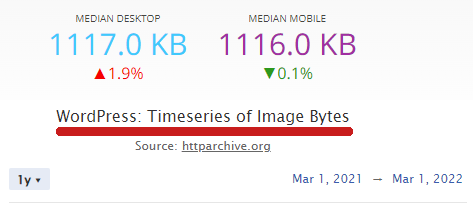Optimizing a website according to best practices is a starting point.
Once a site is published, out the door comes the next process of monitoring performance and improving based on the data.
The key to success is choosing the best SEO data points.
Here are a collection of 12 data points to consider that will help improve all areas of your SEO.
1. Core Web Vitals
Core Web Vitals (CWV) are a set of metrics representing what the page loading experience is for site users. The CWV metrics are also a (minor) ranking factor.
The importance of CWV extends beyond its being a ranking factor. It helps optimize a site for speed, which is known to influence factors such as conversions and earnings.
2. Server Speed
Website server speed influences how fast pages are served and how many of them can be served at the same time.
It’s one of the few conversion- and sales-related variables that can be easily controlled.
Shared hosts can have hundreds or even thousands of websites all competing for the same limited resources.
While shared is fine to begin with, be ready to scale up to a faster host as soon as the site gains traction and begins to succeed.
In some cases, 500 error response messages are an indication that the server is running out of resources, and it’s time to upgrade.
Managed WordPress hosting can be somewhat restrictive of what plugins are allowed to be installed.
But the trade-off is that, because resource-hogging or unnecessary plugins are not an issue, there is more server power available for everyone.
There are many flavors of web hosting – from Shared and Shared Premium to VPS, Cloud, and Dedicated.
There is almost always someone who can say something nice about any given web host and someone else to say something negative.
Sometimes, it can boil down to matching what you are prepared to pay with the level of server control you are able to handle.
If you don’t know anything about server management then something with a simple control panel is the best approach.
3. Publishing Frequency
People want lots of quality content, and they want it all the time. The more content that is published on a daily schedule, the better.
It’s tempting to publish a large group of content and then say the website is done.
For many kinds of sites, especially one that publishes articles, a website is never done.
There is no “set it and forget it” in terms of content.
What that means is that the path to success is created with a constant creation of more content, always more and as often as possible.
It’s not really about generating content that’s ten times better than the competition, either.
It’s simply about generating quality content on a regular basis and doing the best that you can do to provide readers with what you believe they want.
The path to success is almost always through publishing as much quality content as possible.
4. Number Of Indexed Pages
If Google isn’t indexing your pages, that may mean there’s something wrong with your content and/or the entire website.
The Search Console Index Coverage Report provides the data on indexed pages, including discovered but not indexed pages.
If you find that your content is regularly not getting indexed, then this is an opportunity for improvement.
This isn’t a matter of bad luck, and it’s not necessarily a technical issue that’s easily fixed.
Content problems can be hard to identify because it’s difficult to see one’s own content objectively.
Examples Of Content Problems:
- Content is similar to what’s already published.
- Content is thin (Screaming Frog provides Word Count data).
- Content is poorly written.
- Content is not focused enough on the topic.
- Overall, site quality is poor.
5. Search Console Impressions
Search Console shows how often your site appeared in the search results for a variety of keyword phrases. In Google Search Console, this data point is called impressions.
It’s tempting to open up the Search Console to check out which keywords are performing best and bask in the warmth and sunshine of a job well done.
But that’s a waste of time.
Lower ranked keyword phrases are where your time is best spent. Always focus on your lower keywords because this is where the areas to improve can be found.
Some of these opportunities are quick wins, meaning that improving rankings for these phrases is relatively easy.
For other more competitive phrases, it may be that there’s nothing wrong with the content except that it needs more links.
6. Excessive Scrolling
Excessive scrolling is a user experience data point provided by Microsoft Clarity.
Clarity is a free user experience analytics program that is low impact and GDPR compliant. It comes with machine learning that can alert publishers with problems, and provides a variety of metrics that show user behavior on a site.
Content is your most important ranking factor.
The excessive scrolling metric is a flag signaling that improvements to content are needed.
Anything that improves your content is helpful for SEO.
7. Reading Behavior
Reading Behavior is another Microsoft Clarity data point.
This metric shows how many readers are engaged and how many abandon the webpage at the headline.
Pages with an abnormally high abandonment rate need improvement.
The Reading Behavior data point shows you which pages need improvement. This is valuable information.
The way Microsoft Clarity points out content that needs improvement is like employing a junior SEO to work full time creating site audits on a budget of free.
8. Scroll Data
The Scroll Data Microsoft Clarity metric is very important because it reveals how far down webpage users are scrolling.
Identifying where on a webpage visitors are abandoning a page can help debug a technical issue or maybe a problem with the content itself.
9. Missing Or Duplicate Meta Data
It’s easy to drop the ball and roll out a website with unoptimized meta description or title tags.
Duplicate or missing title tags and meta descriptions are especially bad and surprisingly common on websites.
Screaming Frog provides the Missing/Duplicate Meta Description and Title Tag data point.
There’s a free version of Screaming Frog that crawls about 500 pages. So, if you’re just starting out, then give Screaming Frog a try.
10. Image Size
This is a data point related to speed. Mobile data bandwidth can be barely usable.
Even if a site is served on a fast web host, large images are going to pile up like cars on a one-lane freeway exit ramp when they reach a site visitor’s mobile browser.
Image size is one of the easiest things to control, yet one of the variables that many sites ignore when optimizing.
According to HTTP Archive data, for a one-year period between 2021 and 2022, the median average of images per page is 751 KB for the top 1 million websites.
The amount of images per page for the same period of time for WordPress sites is a whopping 1,116.0 KB – that’s over a megabyte of images per page!
 Screenshot from HTTP Archive, May 2022
Screenshot from HTTP Archive, May 2022How big should your image sizes be? As small as you can possibly make them.
Just remember these tips:
- Photographic images – save as JPEG.
- Illustrative images – save as PNG.
- Avoid superimposing text over photographic images.
- Avoid images with lots of details, like trees with thousands of leaves.
- Avoid illustration images that have gradients.
An easy way to shrink images is by serving images in the new WebP format.
Screaming Frog provides image size data for every image on your site. The tool is configurable to flag whatever target size you consider reasonable.
11. Backlinks
While backlinks are very much one of the most important ranking factors, in today’s search algorithms it’s not necessarily the deciding ranking factor.
Search algorithms increasingly use links as part of a ranking algorithm to produce a set of candidate pages to list in the search results.
But, another layer of relevance can be applied that re-ranks the search results for things like relevance, user intent, geolocation, and user expectations, to name a few reasons.
The use of a modification factor or a modification engine is not new – it’s been around for at least 10 years.
So, while links are a highly important ranking factor, links are not necessarily the deciding factor.
This isn’t meant to minimize the importance of links, but simply to make clear where it stands in terms of importance.
Backlink data is available in Google Search Console.
12. Earnings
Earnings might not initially seem like an SEO data point, but it is.
While earnings are the whole point of SEO, earnings are a data point that can work together with other metrics, like traffic and keyword rankings, to tell the entire story of what’s happening. This enables a publisher to make more accurate decisions.
Earnings Indicate Profitability Of Topic
Earnings are an indicator of whether your topic is lucrative.
Some topics have a massive amount of traffic.
But, some of those same topics may have slim profit margins, which can have a negative effect on affiliate commission rates and ad revenue.
Sometimes, keyword phrases with less traffic are more profitable.
Earnings Coordinates With SEO Metrics
Earnings can signal if something has changed in traffic or rankings and contribute to understanding what those changes are.
For example, it’s not uncommon for traffic to decline while earnings remain steady or improve.
That could mean that less relevant traffic is hitting the site, leaving behind the most relevant (and profitable) traffic.
Should you panic? Maybe not.
It could be that the page wasn’t actually relevant for the query, meaning that it may be useful to create a new page to target the lost keyword/s.
This can happen to pages that rank for multiple, different but related keywords, like if a page ranks for plumbing, bathroom installations, and kitchen fixtures and loses all the keyword traffic except for plumbing.
Earnings And Consumer Demand
Earnings can help to signal if consumer demand has changed.
Keyword rankings can remain the same while traffic steadily declines, which will be reflected in earnings.
What’s going on in this scenario is that consumer demand has changed.
This typically happens with the introduction of new product models and sometimes with the introduction of a disruptive new product or service.
SEO Data Points
There are many SEO data points, but the 12 mentioned here are, in my opinion, the most important.
There are many more data points that may prove more useful to your situation.
What’s important is to get thinking about what can signal areas of improvement, identify the causes, then make improvements.
More Resources:
- The 11 Most Important Parts Of SEO You Need To Get Right
- The 9 Most Important SEO KPIs You Should Be Tracking
- Advanced Technical SEO: A Complete Guide
Featured Image: Khosro/Shutterstock





